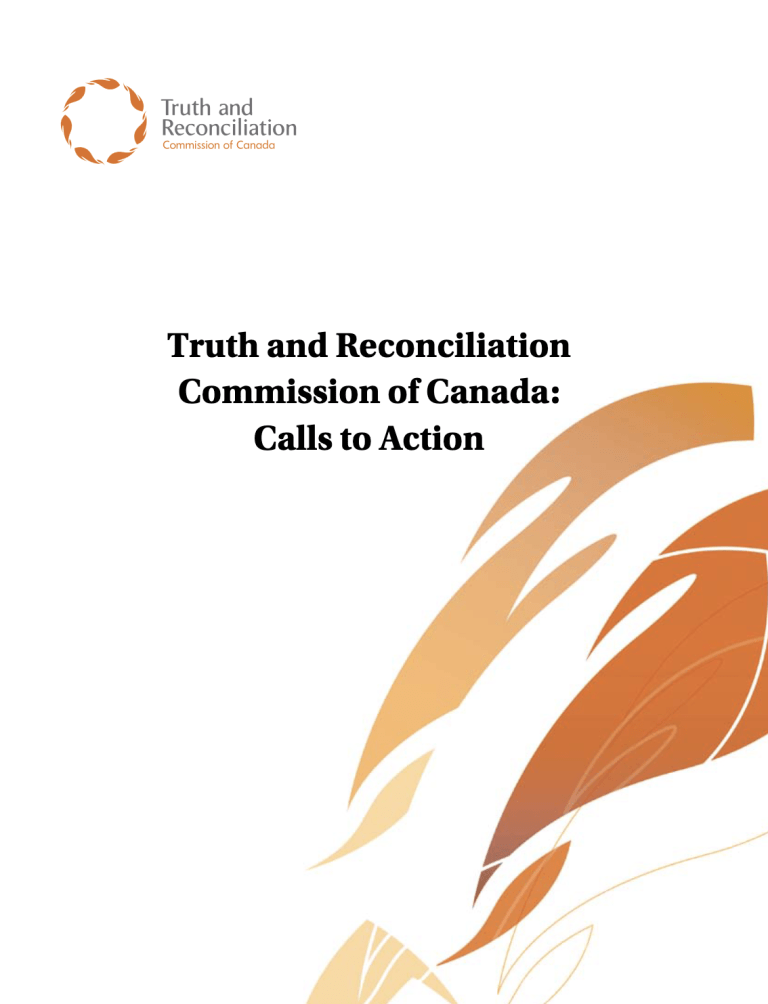95 search results
Reconciliation
Missing children and burial information
Recommendation 71: We call upon all chief coroners and provincial vital statistics agencies that have not provided to the Truth and Reconciliation Commission of Canada their records on the deaths of Aboriginal children in the care of residential school authorities to make these documents available to the National Centre for Truth and Reconciliation.-
Category and theme:
Groups affected:
Location of recommendation:
Reconciliation
Missing children and burial information
Recommendation 72: We call upon the federal government to allocate sufficient resources to the National Centre for Truth and Reconciliation to allow it to develop and maintain the National Residential School Student Death Register established by the Truth and Reconciliation Commission of Canada.-
Category and theme:
Audience:
Groups affected:
Location of recommendation:
Reconciliation
Missing children and burial information
Recommendation 73: We call upon the federal government to work with churches, Aboriginal communities, and former residential school students to establish and maintain an online registry of residential school cemeteries, including, where possible, plot maps showing the location of deceased residential school children.-
Category and theme:
Groups affected:
Location of recommendation:
Reconciliation
Missing children and burial information
Recommendation 74: We call upon the federal government to work with the churches and Aboriginal community leaders to inform the families of children who died at residential schools of the child’s burial location, and to respond to families’ wishes for appropriate commemoration ceremonies and markers, and reburial in home communities where requested.-
Category and theme:
Groups affected:
Location of recommendation:
Reconciliation
Missing children and burial information
Recommendation 75: We call upon the federal government to work with provincial, territorial, and municipal governments, churches, Aboriginal communities, former residential school students, and current landowners to develop and implement strategies and procedures for the ongoing identification, documentation, maintenance, commemoration, and protection of residential school cemeteries or other sites at which residential school children were buried. This is to include the provision of We call upon the federal government to work with provincial, territorial, and municipal governments, churches, Aboriginal communities, former residential school students, and current landowners to develop and implement strategies and procedures for the ongoing identification, documentation, maintenance, commemoration, and protection of residential school cemeteries or other sites at which residential school children were buried. This is to include the provision of appropriate memorial ceremonies and commemorative markers to honour the deceased children.-
Category and theme:
Audience:
Groups affected:
Location of recommendation:
Reconciliation
Missing children and burial information
Recommendation 76: We call upon the parties engaged in the work of documenting, maintaining, commemorating, and protecting residential school cemeteries to adopt strategies in accordance with the following principles:- The Aboriginal community most affected shall lead the development of such strategies.
- Information shall be sought from residential school Survivors and other Knowledge Keepers in the development of such strategies.
- Aboriginal protocols shall be respected before any potentially invasive technical inspection and investigation of a cemetery site.
-
Category and theme:
Groups affected:
Location of recommendation:
Reconciliation
National Centre for Truth and Reconciliation
Recommendation 77: We call upon provincial, territorial, municipal, and community archives to work collaboratively with the National Centre for Truth and Reconciliation to identify and collect copies of all records relevant to the history and legacy of the residential school system, and to provide these to the National Centre for Truth and Reconciliation.-
Category and theme:
Audience:
Groups affected:
Location of recommendation:
Reconciliation
National Centre for Truth and Reconciliation
Recommendation 78: We call upon the Government of Canada to commit to making a funding contribution of $10 million over seven years to the National Centre for Truth and Reconciliation, plus an additional amount to assist communities to research and produce histories of their own residential school experience and their involvement in truth, healing, and reconciliation.-
Category and theme:
Audience:
Groups affected:
Location of recommendation:
Reconciliation
Commemoration
Recommendation 79: We call upon the federal government, in collaboration with Survivors, Aboriginal organizations, and the arts community, to develop a reconciliation framework for Canadian heritage and commemoration. This would include, but not be limited to:- Amending the Historic Sites and Monuments Act to include First Nations, Inuit, and Métis representation on the Historic Sites and Monuments Board of Canada and its Secretariat.
- Revising the policies, criteria, and practices of the National Program of Historical Commemoration to integrate Indigenous history, heritage values, and memory practices into Canada’s national heritage and history.
- Developing and implementing a national heritage plan and strategy for commemorating residential school sites, the history and legacy of residential schools, and the contributions of Aboriginal peoples to Canada’s history.
-
Category and theme:
Groups affected:
Location of recommendation:
Reconciliation
Commemoration
Recommendation 80: We call upon the federal government, in collaboration with Aboriginal peoples, to establish, as a statutory holiday, a National Day for Truth and Reconciliation to honour Survivors, their families, and communities, and ensure that public commemoration of the history and legacy of residential schools remains a vital component of the reconciliation process.-
Category and theme:
Audience:
Groups affected:
Location of recommendation:
